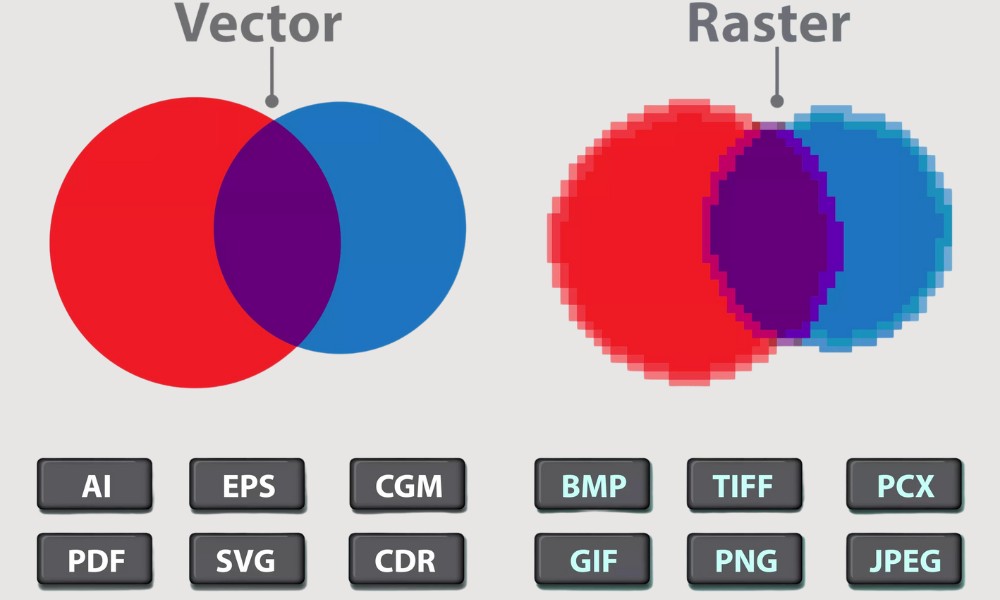Is Vector Better Than JPEG?
Images are essential in the design sector. Image quality is one of the age-old design quandaries. Sharp and clear photos are vital in producing captivating designs, therefore we hunt for them. The last things you want in an image are unnecessary blurred lines that distract from the main message. The question that inevitably arises from this quandary is which image format to use during the design process. JPEGs and vectors are two of the most common options, among a few others.
You may wonder if is Vector better than JPEG. Throughout this article, we will try to give you an insight into this matter.
JPEG/JPG
To put it simply, a JPEG is an image file made up of pixels. It is much like an old-school Super Mario game. JPEG (or JPG) is an abbreviation for Joint Photographic Experts Group. The file size of JPEGs makes them an excellent choice for designers. When you export a file as a JPEG, their compression algorithm reduces the file size significantly. This makes JPEGs an excellent choice for those who want to keep file sizes small or for sharing across platforms with different designers.
The disadvantage of this compression is that the image quality frequently compensates for the reduced file size. If you want a higher image quality, you’ll need to increase the file size as well.
Vector
Vector files are also known as EPS, SVG, or Ai files. The main difference between a vector-based image and a JPEG is its composition. A JPEG is made up of pixels, whereas a vector is made up of vectors. Vectors are made up of points and paths, whereas pixels are made up of small squares that are joined together to form an image. This is why, when scaled up, a JPEG can appear blocky, whereas a vector will remain the same regardless of scale. After all, vectors have the potential to scale and stay pristine in ways that JPEGs cannot.
The disadvantage of vectors is that their file sizes are frequently much larger than those of JPEGs, depending on the project. A vector image also has the disadvantage of taking time.
If you’re given an image, chances are it’s a JPEG, and it may be simpler to use that JPEG than to spend time vectorizing the image. Some things, such as authentic photographs and portraits, simply cannot be converted into a vector format. Most vector conversion service is professional o make vector images so perfectly.
Is Vector Better Than JPEG?
JPEGs and vectors are both extremely popular image formats, each with its own set of advantages and disadvantages. They both serve a purpose and can be useful when creating marketing collateral for your company.
What Exactly Is The Distinction Between Raster (JEPG) And Vector Files?
The two most common formats for visual content are raster and vector files. They represent images in very different ways, so choosing one requires careful consideration. The following are some of the primary distinctions between raster(JPEG) and vector:
Resolution
The resolution of raster(JPEG) and vector files is one of the primary distinctions. A raster file’s resolution is measured in DPI (dots per inch) or PPI (pixels per inch). When you zoom in or out on a raster image, you can see the individual pixels.
Raster files have a wider color range, allow for more color editing, and show finer light and shading than vector files — but they lose image quality when resized. Increase the size of an image to determine whether it is raster or vector. It’s most likely a raster file if the image becomes blurry or pixelated.
Resolution is not an issue with vector image files. Vectors can be resized, rescaled, and reshaped indefinitely without affecting image quality. Vector files are popular for images that must be displayed in a variety of sizes, such as a logo that must fit on both a business card and a billboard.
Uses
Raster(JPEG) files are commonly used to represent digital photographs. Many digital cameras shoot and save photos as raster files, and the images you see online are frequently rasters as well. Raster files are also commonly used for image, photo, and graphic editing.
Vector files are more suitable for digital illustrations, complex graphics, and logos. Because vectors retain their resolution when resized, they are suitable for a wide range of printed formats.
Some projects incorporate raster(JPEG) and vector images. A brochure, for example, may use vector graphics for the company logo but raster files for photography.
File Dimensions
Raster(JPEG) files are typically larger in size than vector files. They can have millions of pixels and extremely fine detail. Their large size can have an impact on device storage space and slow down web page loading speeds. However, raster files can be compressed for storage and web optimization, making sharing faster and easier.
Vector files are much smaller than raster files because they only contain the mathematical formulas that determine the design.
Conversion And Compatibility
Raster files can be opened in a variety of apps and web browsers, making them simple to view, edit, and share. Vector files are not as widely available. Many vector file types require specialized software to open and edit. Though it can be difficult, it is possible to convert vector files to raster or raster files to vector when necessary.

.jpg)


Comments
Post a Comment